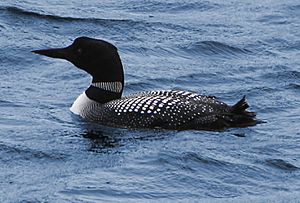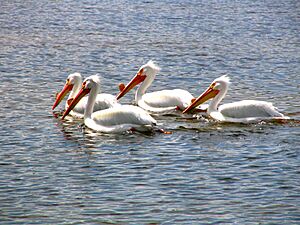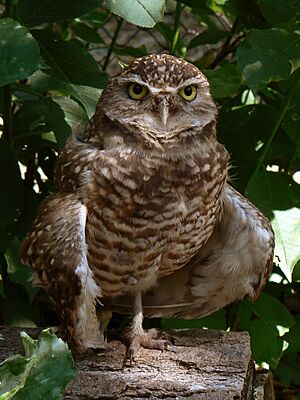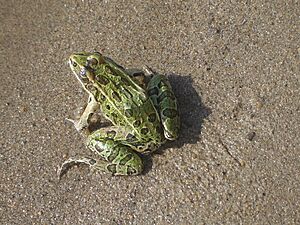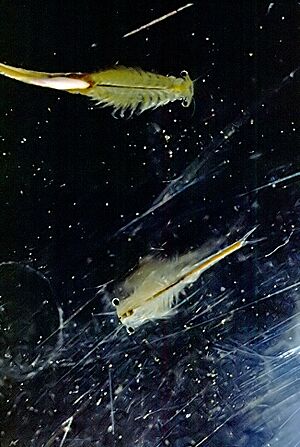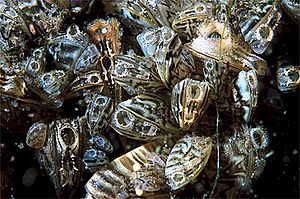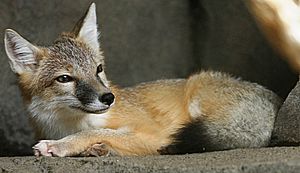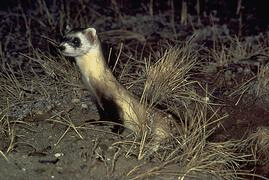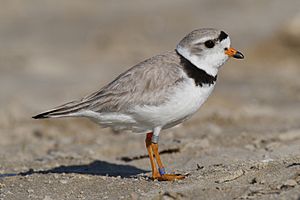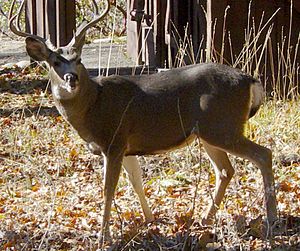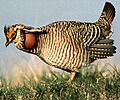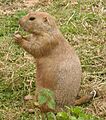Fauna of Saskatchewan facts for kids
The Fauna of Saskatchewan is all about the amazing animals that live in this Canadian province! Saskatchewan is home to many different kinds of animals, both on land and in its waters. From tiny insects to huge mammals, there's a lot to discover.
Two special animals have even been chosen as symbols for Saskatchewan: the sharp-tailed grouse and the white-tailed deer. The province has many different natural areas, called ecosystems. These range from the cold, northern Canadian Shield with its sub-arctic tundra, to the central forests and the wide-open grasslands of the prairie. Each area provides a unique home for different animals, offering them places to live, find food, and raise their young.
Because Saskatchewan has a lot of land and water, but not many people, it's a very important place for many animals. This includes some that are endangered or at risk. Scientists who study wildlife keep track of animal populations. They work to protect species that are struggling and manage populations that might be growing too fast. Many parts of Saskatchewan are protected as parks and reserves. These areas help keep the homes of these animals safe.
Contents
Saskatchewan's Animal Symbols
Saskatchewan has two official animal symbols. The sharp-tailed grouse was chosen in 1945. Later, in 2001, the white-tailed deer became the provincial animal.
Ancient Animals of Saskatchewan
Long, long ago, Saskatchewan looked very different. Scientists have found fossils of animals that lived here millions of years ago. These fossils tell us about the ancient creatures that roamed the land and swam in the seas that once covered the province.
Some of the oldest fossils found are from the Paleocene and Eocene periods. These include ancient mammals, amphibians, and reptiles. Even bird fossils have been found! Imagine huge mammoths and mastodons, like giant elephants, walking across the plains. These animals migrated from other continents, like Asia, using a land bridge that once connected them.
Other amazing prehistoric animals included ancient types of bison, cheetahs, lions, and even saber-toothed cats! There were also early versions of horses, camels, and deer. The American bison, often called "buffalo," is a very important mammal in Saskatchewan's history. Its ancestors, like Bison antiquus, were huge.
Millions of years ago, Saskatchewan was covered by a sea. In this sea lived large reptiles like mosasaurs, plesiosaurs, and giant sea turtles. On land, dinosaurs like Triceratops also lived here. Scientists have found their fossils, especially in places like the Cypress Hills Formation. This area has given us many clues about ancient life.
About 66 million years ago, a big event happened called the Cretaceous–Paleogene extinction event. This event caused many of these prehistoric animals, including the dinosaurs, to disappear. Today, we only find their remains as fossils.
Animals Living in Saskatchewan Today
Saskatchewan is home to many different kinds of animals today. They live in various parts of the province, from the cold north to the warm southern prairies.
Mammals
Saskatchewan has many types of mammals. These include bats, carnivores (meat-eaters), hoofed animals like deer, insectivores (insect-eaters), and rodents. The types of mammals you see depend on where you are in Saskatchewan.
In the far north, in the cold Canadian Shield and Boreal Forest areas, you might find animals that can handle harsh winters. These include the American black bear, barren-ground caribou, moose, wolverine, American marten, timber wolf, red fox, and snowshoe hare.
The Athabasca Plain is a special place where woodland caribou find food in winter. The Arctic fox also lives here. In the Boreal Shield, you can find animals like the little brown bat, Canada lynx, and North American beaver.
Beavers are famous for building dams on small streams. Both beavers and muskrats were once hunted a lot for their fur. Beavers were almost gone in the early 1900s, but their numbers have grown back.
In the central parts of the province, like the Mid-Boreal Upland, you'll see white-tailed deer and mule deer. Smaller mammals like the northern flying squirrel and fisher also live here.
As you move south into the Aspen parkland, which is mostly farmland, you'll find animals like coyotes, striped skunks, North American porcupines, and different kinds of ground squirrels. The white-tailed deer loves this area.
In the southern grasslands, like the Moist Mixed Grassland, you'll see pronghorns, American badgers, and black-tailed prairie dogs. Saskatchewan is the only place in Canada where black-tailed prairie dogs live! The Cypress Hills area, with its higher elevation and forests, is home to moose, elk, and both types of deer.
Birds
Saskatchewan is a birdwatcher's paradise! Over 400 different kinds of birds have been seen here. Many birds migrate through the province, following special routes called flyways. Some birds, like owls, grouse, and finches, stay in Saskatchewan all winter.
In the northern Taiga Shield and Selwyn Lake Upland, you might spot birds like Harris's sparrow, pine grosbeak, spruce grouse, and willow ptarmigan. The common loon and golden eagle are also found in these northern areas.
The Boreal Shield provides breeding grounds for birds like the Bohemian waxwing and Canada goose. The Churchill River Upland has a large population of bald eagles. Many waterfowl, like ducks and geese, live on the region's many lakes. You can also see common ravens, Canada jays, and ospreys in the boreal forests.
In the central Mid-Boreal Upland, common birds include the white-throated sparrow, red-tailed hawk, and ovenbird. The ruffed grouse and American white pelican are often seen in the Mid-Boreal Lowland. The arrival of the American white pelican is a sure sign that spring has arrived!
The Aspen Parkland is home to birds like the house wren, yellow warbler, and western kingbird. This area, with its many ponds and lakes, is a great place for ducks, other waterfowl, and terns to breed.
In the southern grasslands, you'll find the western meadowlark, yellow-headed blackbird, and the piping plover, which is an endangered shorebird. The burrowing owl and sage grouse are also found in the Mixed Grassland. The Cypress Hills are unique, with birds like the trumpeter swan and Townsend's solitaire.
Amphibians and Reptiles
Saskatchewan has several types of amphibians and reptiles. In the southern Mixed Grassland, you might find horned lizards, common garter snakes, common snapping turtles, and the prairie rattlesnake. The western painted turtle also lives here.
Common amphibians in places like Grasslands National Park include the northern leopard frog and chorus frog.
Fish
Saskatchewan's freshwater lakes and rivers are full of fish. In the northern lakes, you can find lake trout, Arctic grayling, white sucker, and northern pike. The central Mid-boreal lowland lakes have yellow perch, walleye, and lake trout.
The Saskatchewan River is home to fish like the lake sturgeon, goldeye, and bigmouth buffalo. Many streams and ponds across the prairies are stocked with rainbow trout, brook trout, and brown trout. You can also find catfish and carp in some rivers, like the Frenchman River.
Saskatchewan has a good fishing industry. The Fort Qu'Appelle Fish Culture Station helps keep lakes and streams healthy by stocking them with fish, especially after harsh winters.
Invertebrates
Invertebrates are animals without backbones, like insects and worms. In the Moist Mixed Grassland, you can see many insects such as the beautiful monarch butterfly, mosquitoes, yellowjacket wasps, bumblebees, dragonflys, and grasshoppers. Gardeners often deal with insects like aphids and whiteflys that can affect plants.
Saskatchewan's freshwater bodies also have many invertebrates. These include different types of clams and molluscs, leeches, freshwater earthworms, crayfish, fairy shrimp, and many tiny creatures like water fleas. Insects like caddisfly larvae, damselfly larvae, and mayfly larvae also live in the water.
Animals That Don't Belong (Invasive Species)
Sometimes, animals that are not native to Saskatchewan are introduced, and they can cause problems. These are called invasive species.
One serious threat to Saskatchewan's waterways is the zebra mussel. These mussels are not from here, and they can take over freshwater habitats, harming native species and even clogging pipes.
In the 1930s, thousands of Richardson's ground squirrels (often called "gophers") and thirteen-lined ground squirrels caused big problems for farmers. They ate crops and dug holes that could injure horses. The government even paid people a small amount for every gopher tail they turned in!
Another interesting story is about the Rocky Mountain locust. These grasshoppers were so numerous in 1875 that they darkened the skies over the American and Canadian plains, eating everything in their path. But mysteriously, by 1902, they had completely disappeared and became extinct. Today, farmers use new methods, like growing resistant crops, to control grasshopper outbreaks.
Protected and Endangered Animals
Many animals in Saskatchewan need our help to survive. Some are considered endangered, meaning they are at high risk of disappearing forever.
The burrowing owl is an endangered species. These small owls live in holes dug by other animals like gophers, prairie dogs, and badgers. Their numbers have dropped because their homes are being destroyed by farming, building, and roads. Pesticides also harm them.
The swift fox is another endangered species. Luckily, some have been raised in captivity and then released back into protected areas to help their populations grow. The lake sturgeon is also a species at risk in the prairie provinces.
Hundreds of years ago, millions of American bison roamed the prairies. Early explorers described them as so numerous that they had to move out of the way for them! But hunting and the destruction of their habitat by settlers caused their numbers to drop dramatically, almost to extinction.
Similarly, in the early 1800s, huge flocks of passenger pigeons would darken the sky for hours during migration. But habitat loss and widespread hunting led to their extinction. The Eskimo curlew, a shorebird once seen in large numbers, also disappeared due to habitat changes and hunting.
The black-footed ferret is another animal that faced a big decline. These ferrets relied on prairie dogs as their main food source. When programs tried to get rid of prairie dogs in the 1930s, the ferrets lost their food and their homes. This caused their population to drop sharply.
Protecting Saskatchewan's Wildlife
Many efforts are made to protect Saskatchewan's amazing wildlife and their homes.
Places like Chaplin, Old Wives, and Reed Lakes are special "Shorebird Reserve Network" sites. They protect three salty lakes and marshes, which are important breeding grounds for the endangered piping plover. Over 67,000 other birds use this area too!
Prince Albert National Park protects a breeding ground for the American white pelican, which is a threatened species. The Quill Lakes are an international wetlands area, recognized for housing over a million shorebirds every year. Redberry Lake Biosphere Reserve is a United Nations-recognized bird sanctuary.
Other important protected areas include Last Mountain Lake, which was Canada's first federal bird sanctuary, and many provincial parks like Cypress Hills Interprovincial Park. The only Canadian colony of prairie dogs is protected in Grasslands National Park. The Ord's kangaroo rat is found only in the Great Sand Hills area.
Highways can be dangerous for wildlife. Animals like porcupines, deer, and other large animals often get hit by cars. Deer, for example, tend to freeze when they see a threat, which can lead to accidents. There are over 3,500 deer-car collisions in Saskatchewan each year. To help, people have put up fences, used special car whistles, and even installed "deer mirrors" along highways. Some new systems can detect large animals near the road and warn drivers.
Other big threats to animal habitats include logging, using pesticides, and oil and gas exploration. When forests are cut down for farming, it changes the homes for forest animals. This can increase animals that like open land, but it hurts those that need forests to survive. Trapping, shooting, and poisoning can directly harm mammals. For fish, things like dumping sand, clearing plants along shorelines, leaking septic tanks, and building dams can threaten their populations.
People Who Studied Nature
Many naturalists have helped us learn about Saskatchewan's wildlife. Peter Fidler (1769–1822) was an explorer who surveyed and mapped Saskatchewan. He also wrote detailed reports about the animals he saw. Loring Woart Bailey (1839–1925) was a naturalist who studied tiny water plants called algae and identified diatoms in Saskatchewan. Grey Owl (1888–1938), whose real name was Archibald Stansfeld Belaney, was a famous conservationist. He lived in Prince Albert National Park and appeared in films to promote wildlife preservation.
Images for kids
-
American robin, (Turdus migratorius) Its arrival signals one of the first signs of spring.




